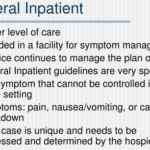Tag: Gip
Articles about general inpatient hospice commonly referred to as GIP.
Articles about general inpatient hospice commonly referred to as GIP.

Dive into hospice General Inpatient (GIP) care through real-life case studies. Discover how GIP can support patients with complex symptoms, learn about eligibility criteria, and understand why this valuable hospice benefit remains underutilized.

This guide covers critical aspects of Hospice GIP discharge planning. From initial evaluation to managing symptoms and effective discharge strategies, this article equips hospice nurses and families with the necessary knowledge for optimal care transitions.

Explore the challenges of hospice General Inpatient (GIP) care, including inappropriate billing and fraud risks. Discover how hospice RN case managers can ensure compliance and quality care through diligent oversight and documentation from admission to discharge.

Explore why and when Hospice General Inpatient Care (GIP) is appropriate, Medicare compliance, eligibility, and what to do if a patient is ineligible.

Discover the differences between hospice general inpatient care (GIP) at a hospital and inpatient care at a facility without a GIP level. Understand eligibility, benefits, and when to choose each type of care for your loved ones.

This comprehensive article delves into Hospice General Inpatient Care, debunks common misconceptions, and explains its importance in end-of-life care.

Explore five essential strategies for maintaining hospice GIP compliance, including documentation best practices, staff preparedness, and emerging technological solutions. This guide helps hospice organizations navigate complex regulatory requirements while ensuring quality patient care.

Hospice General Inpatient Care (GIP) provides short-term, intensive care for patients experiencing severe pain or symptoms that can't be managed at home. Learn about GIP eligibility, benefits, and how it helps both patients and families during challenging times. Discover key details and important considerations for this essential hospice service.

Hospice care offers a specialized service known as the Continuous Care Benefit. This unique care type provides crucial 24-hour support to patients who are going through an acute symptom crisis. In this article, we'll delve into what Continuous Care Benefit is, who's eligible for it, how it operates, why it's important, how to access it, and its duration.

GIP, or General Inpatient Hospice, is an often misunderstood aspect of hospice care. Both hospital staff and families sometimes have misconceptions about GIP. Families may assume it's readily available upon request, while hospital professionals may believe it allows patients to remain in the hospital indefinitely, even when death is weeks away. This article will clarify the basics of GIP for hospice, including eligibility requirements, doctor's orders, care plans, documentation, and education. We'll conclude with two real-life cases to illustrate these points.